
Rick & Ami's 8 Year Sailing Adventure
...or, how to log 8000 miles in 8 years!
12 January 2010 | Southern Caribbean
01 January 2010 | Bahia de Chalon, Colombia
19 May 2009 | San Blas Islands, Panama
25 December 2008
23 August 2007
05 August 2007 | Mochima, Venezuelan coast
25 May 2007 | Trinidad, West Indies
28 February 2007 | Trinidad, West Indies
23 December 2005 | Trinidad, West Indies
12 August 2005 | Trinidad
14 July 2005 | Trinidad, West Indies
28 June 2005 | St. Lucia, Eastern Caribbean
20 June 2005
09 December 2004 | Peru
10 June 2004 | Chatham Bay, Union Island, The Grenadines
19 March 2004 | Trinidad, West Indies
15 February 2004
22 December 2003 | Trinidad, West Indies
11 December 2003 | Trinidad, West Indies
13 November 2003 | Trinidad, West Indies
Sailing In Paradise
12 January 2010 | Southern Caribbean
Ami
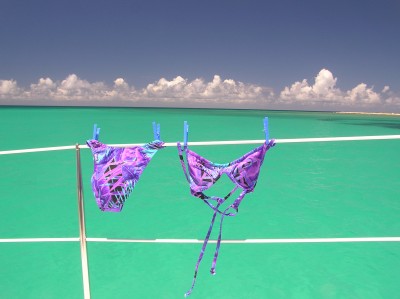
The past 8+ years have been an amazing adventure for us. We logged over 8,000 nautical miles in the eastern and southern Caribbean. We delighted in the music and culture of every island or country we visited. We learned French and Spanish, and are conversational in Papamientu and Kuna. We've become quite self-sufficient on the boat, living in remote areas for months at a time. We've made lifelong friendships everywhere we've visited.
Though there are many challenges living on a boat, and traveling in underdeveloped countries, this cruising lifestyle is so rich and wonderful, and we treasure every experience.
We finally uploaded the cruising letters we've been sending out for the last 8 years, and lots of fun photos, to this BLOG site. Now friends and family can check our current position, and see pictures of where we are. Hope that this is a good tool for us to stay connected.
Though there are many challenges living on a boat, and traveling in underdeveloped countries, this cruising lifestyle is so rich and wonderful, and we treasure every experience.
We finally uploaded the cruising letters we've been sending out for the last 8 years, and lots of fun photos, to this BLOG site. Now friends and family can check our current position, and see pictures of where we are. Hope that this is a good tool for us to stay connected.
Happy New Year from Colombia!
01 January 2010 | Bahia de Chalon, Colombia
Ami
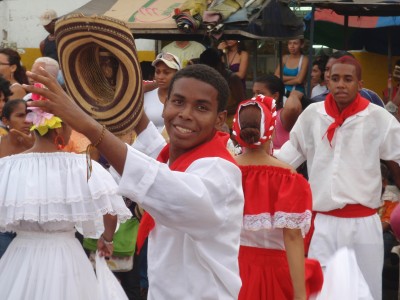
"I'm going to lose weight, stop smoking, and spend more quality time with the kids." Every year, Rick announces the same three New Year's Resolutions. He cracks me up.
It's New Year's Day. We're anchored in Bahia de Cholon, a beautiful, quiet, mangrove-lined bay on the Caribbean coast of Colombia. It's so tranquil here, though we are only about 15 miles down the coast from the hustle and bustle of Cartagena. We're fully provisioned, have completed our many boat projects, and are ready to spend the next 4-6 months in very remote places. We're waiting for a good weather window to sail to the San Blas Islands of Panama.
New Year's Day is a good time to reflect on the highlights of the past year. Our eighth year on the boat was full of delightful adventure, new experiences, and plenty of challenges. We logged about 1250 nautical miles since leaving the ABC Islands in November 08, sailing from Curacao to Cartagena, then to the San Blas, and back to Cartagena.
We fell in love with Colombia....the Latin music, the rich culture, and the friendly people. The old walled city, El Centro Historico, was magical, just exploding with history and charm. We loved to walk the streets in the evenings, delighting in the old Colonial architecture, the flower-laden balconies, and narrow cobblestone streets. It was not unusual to hear a band playing traditional Colombian music on the corner, with an accordion, a local flute, a clarinet, and some drums. And maybe a dance troupe, asking for tips from the Colombian tourists, as they dance their traditional Afro-Colombiano folk dances in the public squares.
We were captivated by the natural beauty of the islands of the San Blas archipelago, along the Caribbean coast of Panama. We anchored alone off many a deserted, palm-fringed island. We explored miles and miles of coral reef. And we got to meet the indigenous Kuna Indians, the only inhabitants of the San Blas, who live as they have always lived, primatively, in near isolation. What a treat to visit their villages, and learn about their lifestyle and culture. A really special treat, as the only visitors the Kunas are likely to meet are cruisers like ourselves.
We also enjoyed a wonderful visit with family and friends in California last summer...lots of love and laughter.
We hope this next year brings everyone lots of love and laughter, good heath and hope, and some adventure....
Nuevo ano feliz!!!!!
It's New Year's Day. We're anchored in Bahia de Cholon, a beautiful, quiet, mangrove-lined bay on the Caribbean coast of Colombia. It's so tranquil here, though we are only about 15 miles down the coast from the hustle and bustle of Cartagena. We're fully provisioned, have completed our many boat projects, and are ready to spend the next 4-6 months in very remote places. We're waiting for a good weather window to sail to the San Blas Islands of Panama.
New Year's Day is a good time to reflect on the highlights of the past year. Our eighth year on the boat was full of delightful adventure, new experiences, and plenty of challenges. We logged about 1250 nautical miles since leaving the ABC Islands in November 08, sailing from Curacao to Cartagena, then to the San Blas, and back to Cartagena.
We fell in love with Colombia....the Latin music, the rich culture, and the friendly people. The old walled city, El Centro Historico, was magical, just exploding with history and charm. We loved to walk the streets in the evenings, delighting in the old Colonial architecture, the flower-laden balconies, and narrow cobblestone streets. It was not unusual to hear a band playing traditional Colombian music on the corner, with an accordion, a local flute, a clarinet, and some drums. And maybe a dance troupe, asking for tips from the Colombian tourists, as they dance their traditional Afro-Colombiano folk dances in the public squares.
We were captivated by the natural beauty of the islands of the San Blas archipelago, along the Caribbean coast of Panama. We anchored alone off many a deserted, palm-fringed island. We explored miles and miles of coral reef. And we got to meet the indigenous Kuna Indians, the only inhabitants of the San Blas, who live as they have always lived, primatively, in near isolation. What a treat to visit their villages, and learn about their lifestyle and culture. A really special treat, as the only visitors the Kunas are likely to meet are cruisers like ourselves.
We also enjoyed a wonderful visit with family and friends in California last summer...lots of love and laughter.
We hope this next year brings everyone lots of love and laughter, good heath and hope, and some adventure....
Nuevo ano feliz!!!!!
Kuna Yala, in the San Blas
19 May 2009 | San Blas Islands, Panama
Ami
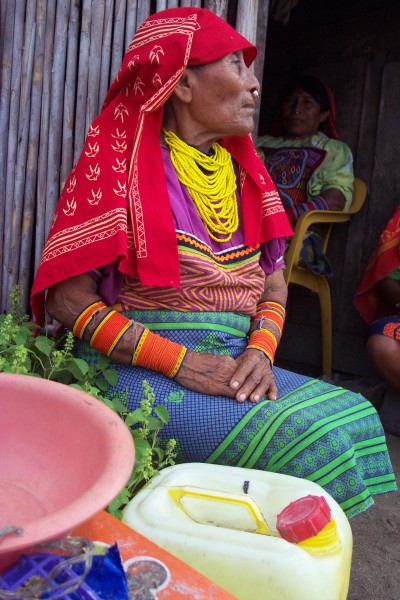
We can hear the roar of the huge breakers crashing on the outside reef. Smell the sweet salt air. Feel the sea breeze on our faces. And as we look around us, we are just overcome by the natural beauty of this place.
For the last five months, we have been sailing and exploring in the San Blas Islands, an archipelago of about 360 islands along the Caribbean coast of Panama. The islands are gorgeous; most are small and uninhabited, with white sand beaches and swaying palms. The islands are protected by miles and miles of barrier reef, giving us delightful sailing conditions, with strong trade winds and flat seas. We could explore these islands for years. This is truly a cruiser's paradise!
The San Blas Islands are in Kuna Yala, the territory of the Kuna Indians, one of the 7 indigenous Indian tribes of Panama. The Kunas live on 48 of the larger islands here, and collect coconuts from the smaller islands. They still live as they always have, with their own religion, their medicine men, and their ancient customs.
The Kuna women still wear the traditional clothing they've worn for decades. Notice the gold ring in her nose, a sign of beauty. Around her torso she has wrapped a "mola", a hand-stitched reverse appliqué that is unique to the Kunas. This one took her 3 months to stitch, and has birds and animals and traditional geometric shapes on it. The Kuna women adorn their arms and calves with strings of beads, to ward off evil spirits. She is sitting in front of the family hut, made of bamboo sticks, with a palm frond roof.
The Kunas are friendly and welcoming. Though most have had minimal formal education, if any, they seem quite intelligent, and hard working. There is a sense of peace and tranquility as we walk around the villages. The children often follow us, and giggle when we try out some of our newly-learned Kuna phrases with them!!! Many of the men speak at least a little Spanish, especially those who trade with the Colombian trading boats that bring rice and flour and such to trade for the Kuna's coconuts.
The Kuna women cook over an open fire, feeding their families mostly fish, rice, coconuts and plantains... which is really what we've been eating too! Except when, now and then, a young Kuna man from the biggest island in this area, Nargana, comes out to the outer islands with fresh produce to sell to the cruisers!!!!! What a treat that is!
The water is gorgeous here, so warm and clear, and we are constantly swimming or free-diving. The reefs are teeming with life, and we feel fortunate to be able to observe and discover. We do eat fresh fish nearly every day, as Rick has become a better fisherman...at first we were lucky if he caught a little appetizer! Now, it's fish soup, fish pasta, fish patties, and the good old standby of just BBQed filets....!
In the 1920's, the Kunas staged a bloody revolution against the government of Panama, and won the right to self-rule. Now each village is led by a 'sahila', or chief. Each island village has a large hut, called the 'congresso', where nightly village meetings are held to discuss events and solve problems. No one is allowed to speak directly to the sahila during the congresso, so there is a 'translator'. The sahila lays in a hammock, as do many of the elders, who have been known to fall asleep during some of the less exciting meetings! Every few months, the sahilas from all the islands meet for a general congresso, to discuss issues that affect all of Kuna Yala. There are no police. No jails. There is no crime. It's so refreshing.
The Kuna men spend much of their time fishing. They use a dugout canoe, called an 'ulu', which they sail downwind, and row upwind. The sails are made of an odd assortment of fabrics, though sometimes we see an ulu with a sail made of nice sailcloth...most likely a donation from a fellow cruiser.
The men row or sail their ulus to the mainland to fetch fresh water from the rivers, as there is no water on the islands. Just outside each family hut, you'll find several barrels of fresh water; cups are dipped into the barrels to get water for drinking, cooking, and bathing. The women make regular trips to the rivers to do laundry and bathe...some of the islands are far from the mainland rivers and we see the women expertly handling their ulus, even in the roughest of conditions.
In addition, each family grows some fruits and vegetables along the banks of the mainland rivers which meander through the dense rainforest of the Darien Wilderness. They tend to grow yucca, plantains, mangos, pineapple, papaya, and a red rice that they grind into meal. They also ferment the rice to make a strong alcoholic drink called 'chicha', which is drunk at festivals and ceremonies, to help drive away evil spirits. Sometimes they hunt the wild boar and wild turkey in the mountains, to supplement their fish diets.
What a tranquil life it has been here. Intense natural beauty. Interesting Kuna culture. Endless hours exploring underwater. Making homemade bread and yogurt. Eating fresh fish. Easy sailing between islands. Star gazing at night. And best of all, time to just be together.
However.....a few good thunderstorms remind us that we'd best head back to Cartagena for the rainy season....there's just too much lightning in the San Blas summers for our liking! Before leaving the San Blas, one of our new Kuna friends, Bredio, gave us a 'nuchu', a small Kuna figure that he carved from local balsa wood, to ward off evil spirits and protect us as we sadly left Kuna Yala.
Our 36 hour sail back to Cartagena was, like everything we do, an adventure. As we started out, we enjoyed a glorious sail in nearly perfect conditions. But a series of squalls, with high winds from different directions, churned up the sea, making the next leg of the trip rough and uncomfortable. At night, the wind died completely, so we had to motor....yuck!
The last leg of the passage, we again enjoyed ideal conditions. And, to our delight, a pod of spinner dolphins came to welcome us to Colombia! Spinner dolphins are smaller and more acrobatic than the better known Atlantic bottlenose dolphins, and they put on quite a show as they jumped high out of the water, doing spins and flips that would get high grades at Sea World!
For the last five months, we have been sailing and exploring in the San Blas Islands, an archipelago of about 360 islands along the Caribbean coast of Panama. The islands are gorgeous; most are small and uninhabited, with white sand beaches and swaying palms. The islands are protected by miles and miles of barrier reef, giving us delightful sailing conditions, with strong trade winds and flat seas. We could explore these islands for years. This is truly a cruiser's paradise!
The San Blas Islands are in Kuna Yala, the territory of the Kuna Indians, one of the 7 indigenous Indian tribes of Panama. The Kunas live on 48 of the larger islands here, and collect coconuts from the smaller islands. They still live as they always have, with their own religion, their medicine men, and their ancient customs.
The Kuna women still wear the traditional clothing they've worn for decades. Notice the gold ring in her nose, a sign of beauty. Around her torso she has wrapped a "mola", a hand-stitched reverse appliqué that is unique to the Kunas. This one took her 3 months to stitch, and has birds and animals and traditional geometric shapes on it. The Kuna women adorn their arms and calves with strings of beads, to ward off evil spirits. She is sitting in front of the family hut, made of bamboo sticks, with a palm frond roof.
The Kunas are friendly and welcoming. Though most have had minimal formal education, if any, they seem quite intelligent, and hard working. There is a sense of peace and tranquility as we walk around the villages. The children often follow us, and giggle when we try out some of our newly-learned Kuna phrases with them!!! Many of the men speak at least a little Spanish, especially those who trade with the Colombian trading boats that bring rice and flour and such to trade for the Kuna's coconuts.
The Kuna women cook over an open fire, feeding their families mostly fish, rice, coconuts and plantains... which is really what we've been eating too! Except when, now and then, a young Kuna man from the biggest island in this area, Nargana, comes out to the outer islands with fresh produce to sell to the cruisers!!!!! What a treat that is!
The water is gorgeous here, so warm and clear, and we are constantly swimming or free-diving. The reefs are teeming with life, and we feel fortunate to be able to observe and discover. We do eat fresh fish nearly every day, as Rick has become a better fisherman...at first we were lucky if he caught a little appetizer! Now, it's fish soup, fish pasta, fish patties, and the good old standby of just BBQed filets....!
In the 1920's, the Kunas staged a bloody revolution against the government of Panama, and won the right to self-rule. Now each village is led by a 'sahila', or chief. Each island village has a large hut, called the 'congresso', where nightly village meetings are held to discuss events and solve problems. No one is allowed to speak directly to the sahila during the congresso, so there is a 'translator'. The sahila lays in a hammock, as do many of the elders, who have been known to fall asleep during some of the less exciting meetings! Every few months, the sahilas from all the islands meet for a general congresso, to discuss issues that affect all of Kuna Yala. There are no police. No jails. There is no crime. It's so refreshing.
The Kuna men spend much of their time fishing. They use a dugout canoe, called an 'ulu', which they sail downwind, and row upwind. The sails are made of an odd assortment of fabrics, though sometimes we see an ulu with a sail made of nice sailcloth...most likely a donation from a fellow cruiser.
The men row or sail their ulus to the mainland to fetch fresh water from the rivers, as there is no water on the islands. Just outside each family hut, you'll find several barrels of fresh water; cups are dipped into the barrels to get water for drinking, cooking, and bathing. The women make regular trips to the rivers to do laundry and bathe...some of the islands are far from the mainland rivers and we see the women expertly handling their ulus, even in the roughest of conditions.
In addition, each family grows some fruits and vegetables along the banks of the mainland rivers which meander through the dense rainforest of the Darien Wilderness. They tend to grow yucca, plantains, mangos, pineapple, papaya, and a red rice that they grind into meal. They also ferment the rice to make a strong alcoholic drink called 'chicha', which is drunk at festivals and ceremonies, to help drive away evil spirits. Sometimes they hunt the wild boar and wild turkey in the mountains, to supplement their fish diets.
What a tranquil life it has been here. Intense natural beauty. Interesting Kuna culture. Endless hours exploring underwater. Making homemade bread and yogurt. Eating fresh fish. Easy sailing between islands. Star gazing at night. And best of all, time to just be together.
However.....a few good thunderstorms remind us that we'd best head back to Cartagena for the rainy season....there's just too much lightning in the San Blas summers for our liking! Before leaving the San Blas, one of our new Kuna friends, Bredio, gave us a 'nuchu', a small Kuna figure that he carved from local balsa wood, to ward off evil spirits and protect us as we sadly left Kuna Yala.
Our 36 hour sail back to Cartagena was, like everything we do, an adventure. As we started out, we enjoyed a glorious sail in nearly perfect conditions. But a series of squalls, with high winds from different directions, churned up the sea, making the next leg of the trip rough and uncomfortable. At night, the wind died completely, so we had to motor....yuck!
The last leg of the passage, we again enjoyed ideal conditions. And, to our delight, a pod of spinner dolphins came to welcome us to Colombia! Spinner dolphins are smaller and more acrobatic than the better known Atlantic bottlenose dolphins, and they put on quite a show as they jumped high out of the water, doing spins and flips that would get high grades at Sea World!
Curacao to Cartagena
25 December 2008
Ami
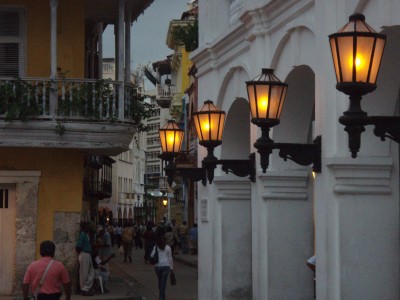
It's Christmas morning. We woke to a balmy 85 degrees and a nice 15 knot breeze, making it feel quite comfortable on the boat. A relief from the heat and humidity we've endured during the last few months, partly because there has just been no wind. But mostly because we're in the tropics, only 10 degrees from the equator.
We're anchored in Bahia de Cartagena de Indias, just alongside the old city of Cartagena. We've been in Colombia for a few months now, pleasantly surprised at how much we're enjoying the culture, the music, and, most of all, the Colombians.
Like most people, we thought that Colombia was a dangerous country to visit, with drug lords and kidnappings and anti-American hatred. However, Colombia has changed over the last 7-10 years, and other cruisers reported that is very safe, and one of the countries they most enjoyed visiting. So, after much research, we decided not to bypass Colombia on our way to Panama after all.
On our trip here from Curacao, we found the Colombian coastline mostly uninhabited, and quite dramatic, with rainforest covered mountains, and enticing little coves just begging to be explored. We loved Bahia Guayraca, which was part of a large national park. A fisherman, Reynaldo, took us hiking in the hills behind the little fishing village, showing us the remains of some pueblos of the indigenous Torona Indians, and it was fun hunting for pottery chips and other artifacts. Leaving Bahia Guayraca, Rick caught a huge tuna, which fed us well for many dinners and lunches!
But the highlight of Colombia so far has been Cartagena, the oldest city in the Americas. The walled Centro Historico has been renovated, and is perhaps the most magical city we've ever visited, just dripping with history and exploding with culture......Latin music and dancing in the streets, ancient cathedrals, impressive forts, horse-drawn buggies, and vine-covered balconies overlooking narrow cobblestone streets. We can see the old city from our boat, and hear the music till wee hours of the morning. It is indeed safe here, especially in the old city. The Colombianos love Americans, and often stop us on the street to ask us about life in the States. Needless to say, our Spanish is getting quite good!!!!
Just a quick sail from Cartagena are some lush, lightly populated islands called Los Rosarios. After a month of indulging in the vibrant city life of Cartagena, it felt great to swim in the crystal clear water, to kayak and free dive, and to do some serious stargazing! A hike to the small pueblo on Isla Grande, which was really quite small but the largest of the islands, was like a walk back in time. A small community of people surviving on fishing, living in thatched roof huts with dirt floors, happy barefoot kids running everywhere, and big smiles on every kind face we saw. We spent hours listening to stories that some locals freely shared with us, about their lives there in Los Rosarios, and their quiet little community.
After we left Venezuela last year, we spent some time in the Dutch Antilles islands of Bonaire and Curacao, enjoying the Dutch culture, but not the Dutch prices! Bonaire was a delight, as the entire island is a protected marine park. The diving is spectacular there; the reef is alive with a biodiversity of fish and coral life that is supposedly unrivaled in the world. We did over a hundred dives there, and identified over 300 varieties of fish, and well, we just really had a blast!
After the holiday festivities here in Cartagena, we plan to head west to Panama. We are looking forward to exploring the San Blas Islands, an archipelago of about 360 islands that stretch from the Colombian border to the Panama Canal zone. Only a handful of the islands are inhabited, and the only inhabitants are the Kuna Yala Indians, an indigenous tribe that fought with Panama in the 1930s for the right to self-govern, and so century old tribal laws and practices are intact and in place. We are busy preparing the boat, and provisioning for months of sailing among these beautiful, remote islands.
We hope that everyone is enjoying the holidays. May this new year bring joy and love to all! Please write when you get a chance....we will have internet access until we leave for the San Blas in mid-January.
We're anchored in Bahia de Cartagena de Indias, just alongside the old city of Cartagena. We've been in Colombia for a few months now, pleasantly surprised at how much we're enjoying the culture, the music, and, most of all, the Colombians.
Like most people, we thought that Colombia was a dangerous country to visit, with drug lords and kidnappings and anti-American hatred. However, Colombia has changed over the last 7-10 years, and other cruisers reported that is very safe, and one of the countries they most enjoyed visiting. So, after much research, we decided not to bypass Colombia on our way to Panama after all.
On our trip here from Curacao, we found the Colombian coastline mostly uninhabited, and quite dramatic, with rainforest covered mountains, and enticing little coves just begging to be explored. We loved Bahia Guayraca, which was part of a large national park. A fisherman, Reynaldo, took us hiking in the hills behind the little fishing village, showing us the remains of some pueblos of the indigenous Torona Indians, and it was fun hunting for pottery chips and other artifacts. Leaving Bahia Guayraca, Rick caught a huge tuna, which fed us well for many dinners and lunches!
But the highlight of Colombia so far has been Cartagena, the oldest city in the Americas. The walled Centro Historico has been renovated, and is perhaps the most magical city we've ever visited, just dripping with history and exploding with culture......Latin music and dancing in the streets, ancient cathedrals, impressive forts, horse-drawn buggies, and vine-covered balconies overlooking narrow cobblestone streets. We can see the old city from our boat, and hear the music till wee hours of the morning. It is indeed safe here, especially in the old city. The Colombianos love Americans, and often stop us on the street to ask us about life in the States. Needless to say, our Spanish is getting quite good!!!!
Just a quick sail from Cartagena are some lush, lightly populated islands called Los Rosarios. After a month of indulging in the vibrant city life of Cartagena, it felt great to swim in the crystal clear water, to kayak and free dive, and to do some serious stargazing! A hike to the small pueblo on Isla Grande, which was really quite small but the largest of the islands, was like a walk back in time. A small community of people surviving on fishing, living in thatched roof huts with dirt floors, happy barefoot kids running everywhere, and big smiles on every kind face we saw. We spent hours listening to stories that some locals freely shared with us, about their lives there in Los Rosarios, and their quiet little community.
After we left Venezuela last year, we spent some time in the Dutch Antilles islands of Bonaire and Curacao, enjoying the Dutch culture, but not the Dutch prices! Bonaire was a delight, as the entire island is a protected marine park. The diving is spectacular there; the reef is alive with a biodiversity of fish and coral life that is supposedly unrivaled in the world. We did over a hundred dives there, and identified over 300 varieties of fish, and well, we just really had a blast!
After the holiday festivities here in Cartagena, we plan to head west to Panama. We are looking forward to exploring the San Blas Islands, an archipelago of about 360 islands that stretch from the Colombian border to the Panama Canal zone. Only a handful of the islands are inhabited, and the only inhabitants are the Kuna Yala Indians, an indigenous tribe that fought with Panama in the 1930s for the right to self-govern, and so century old tribal laws and practices are intact and in place. We are busy preparing the boat, and provisioning for months of sailing among these beautiful, remote islands.
We hope that everyone is enjoying the holidays. May this new year bring joy and love to all! Please write when you get a chance....we will have internet access until we leave for the San Blas in mid-January.
Venezuela: Isla Blanquilla
23 August 2007
Ami
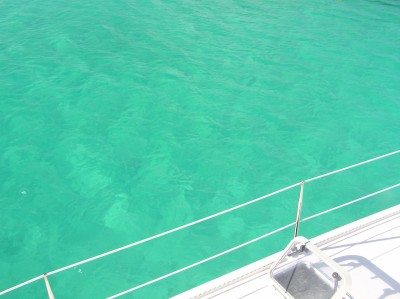
I am writing from Isla Blanquilla, Venezuela. One of the most beautiful spots we've ever anchored in. The water is gin-clear. Our boat is anchored in about 22 feet of water, yet we can see the ripples in the sand below the boat. There are 3 lone palm trees on the beach, the sand is whiter than white, so enticing. There are several rocky points, hosting plenty of live coral, with lots of fish, seemingly unafraid, lots of activity, and great visibility. The water is 83 degrees, the air is 83 degrees, and the humidity is less than in the Eastern Caribbean, making it a bit more comfortable here. The island is quite dry, covered with cactus and shrubby things, so different from the lush rainforests of the other islands we've visited.
Last night Rick BBQed a mid-sized tuna that he caught on our sail here, and we ate it with the mango salsa I had made from deliciously ripe, sweet mangos. The night was quiet, but for the wind in the rigging, and an occasional 'splash' from a fish jumping. Blanquilla is uninhabited, so the night skies are exploding with stars, with stars that you just can't see in the vicinity of civilization's lights. There are 8 other boats anchored around the island, 3 of which we know, but we've been so enjoying the quiet and tranquility that we haven't felt like socializing yet. We're enjoying the complete relaxation that a place like this encourages.
When we were preparing for this adventure, working so hard to organize our lives so that we could sell everything and buy a boat and go cruising, this is the kind of place we yearned to be in. The kind of place that they write about in the cruising magazines. The kind of place that other cruisers rave about.
Our experiences in Trinidad and the Eastern Caribbean were richer that we could have ever imagined, ever planned for. To become immersed in such a different culture was a highlight of our lives together. We spent 6 years there, with more than half the time in Trinidad. Except for the family and friends that we miss, Trinidad feels so much more like home than California ever did. It was so hard to leave.
But now we are exploring new islands and our pace has relaxed considerably. It's time for this next part of the adventure. There are so many small islands to explore in this Venezuelan archipelago, and we've got all the time in the world. What a wonderful feeling!
Last night Rick BBQed a mid-sized tuna that he caught on our sail here, and we ate it with the mango salsa I had made from deliciously ripe, sweet mangos. The night was quiet, but for the wind in the rigging, and an occasional 'splash' from a fish jumping. Blanquilla is uninhabited, so the night skies are exploding with stars, with stars that you just can't see in the vicinity of civilization's lights. There are 8 other boats anchored around the island, 3 of which we know, but we've been so enjoying the quiet and tranquility that we haven't felt like socializing yet. We're enjoying the complete relaxation that a place like this encourages.
When we were preparing for this adventure, working so hard to organize our lives so that we could sell everything and buy a boat and go cruising, this is the kind of place we yearned to be in. The kind of place that they write about in the cruising magazines. The kind of place that other cruisers rave about.
Our experiences in Trinidad and the Eastern Caribbean were richer that we could have ever imagined, ever planned for. To become immersed in such a different culture was a highlight of our lives together. We spent 6 years there, with more than half the time in Trinidad. Except for the family and friends that we miss, Trinidad feels so much more like home than California ever did. It was so hard to leave.
But now we are exploring new islands and our pace has relaxed considerably. It's time for this next part of the adventure. There are so many small islands to explore in this Venezuelan archipelago, and we've got all the time in the world. What a wonderful feeling!
Dolphins Join Us For Some Fun
05 August 2007 | Mochima, Venezuelan coast
Rick
While underway, dolphins will often join us, approaching from a distance to enjoy a little ride in our bow wave. We will sit on the crossbeam and watch them while they swim, dive, and jump out of the water. And then, just as quickly as they appeared, they peel off like a squadron of jet fighters, and are gone.
| Vessel Name: | Tara Vana |
| Vessel Make/Model: | Nautitech 435 catamaran |
| Hailing Port: | Laguna Beach, CA |
| Crew: | Rick & Ami Bergstrom |
| About: | With little previous sailing experience, we decided to sell everything we owned, buy a cruising catamaran, and explore the world. |
| Extra: | Retired at 40, we've been living aboard Tara Vana in the Caribbean since Sept. 2001. It has been a rich and varied experience. New people. New cultures. Lots of dance and music. And spectacular scenery. |
Gallery not available
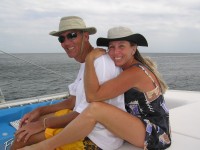
Who: Rick & Ami Bergstrom
Port: Laguna Beach, CA






